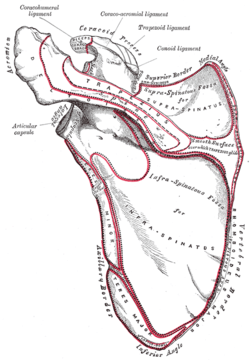Ewart's sign

Left scapula. Dorsal surface. (Ewart's sign below angle of the left scapula.)[1]
Ewart's sign is a set of finding on physical examination in people with large collections of fluid around their heart (pericardial effusions).
Dullness to percussion (described historically as "woody" in quality), egophony, and bronchial breath sounds may be appreciated at the inferior angle of the left scapula when the effusion is large enough to compress the left lower lobe of the lung, causing consolidation or atelectasis.
Eponym
It was first described by William Ewart in 1896.[2][3]
References
- ↑ "Definition: Ewart's sign from Online Medical Dictionary".
- ↑ synd/2346 at Who Named It?
- ↑ W. Ewart: Practical aids in the diagnosis of pericardial effusion, in connection with the question as to surgical treatment. British Medical Journal, London, 1896, 1: 717-721.
| ||||||||||||||||||||||||||||||||||||||||||||||||||||||||||||||||||